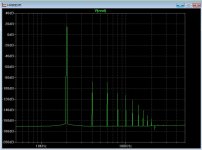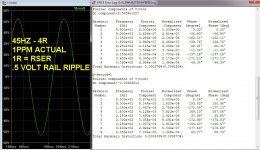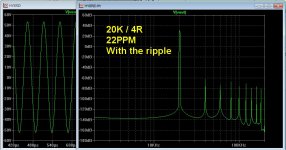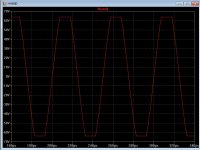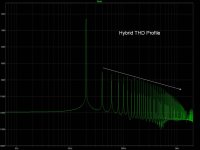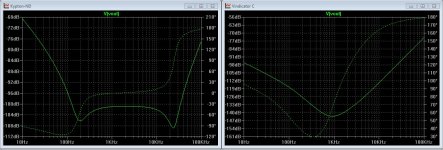Vindicator V and C .....
That last design was a VFA primary TIS , Jay.
I will do do both CFA / VFA versions of this design. (Vindicator C and V).
As far as ASTX's comments about not enough 20K gain margin and insufficient
slew. Geeeezzz . (below 1)
But I did get >125V/us out of this one. Everything is a compromise.
More (slew) could be had with more current at the final folded cascodes.
The "kleinschmidt / Groner TIS"is the limiting factor here.
Is SLEW the only goal ?
By listening to my Spooky now , I don't think so.
Add (simulated) serial resistance to a typical CFA at 45hz and then this one -
you will see. (below 2).
PS - this amp is .5 ppm to 5 ppm - from 500hz - 10Khz (with the ripple).
Thimios's test results on the Kypton V/ND and listening to my superior
Spookyamp showed that there is a lot more to a exceptional amp than just slew.
His tests show the CFA (Kypton - ND) fell far short of optimal.
One could power these CFA IPS's from a highly regulated separate supply and
MAYBE approach a simulated result.
(below 3 and 4 ) worst case high output and overload.
This will be first on Sprint (PCB) 16 semi's plus servo , fewer resistors than
spooky ..... still , a "busy" layout.
OS
What about the Slew Rate weakness as pointed by astx?
That last design was a VFA primary TIS , Jay.
I will do do both CFA / VFA versions of this design. (Vindicator C and V).
As far as ASTX's comments about not enough 20K gain margin and insufficient
slew. Geeeezzz . (below 1)
But I did get >125V/us out of this one. Everything is a compromise.
More (slew) could be had with more current at the final folded cascodes.
The "kleinschmidt / Groner TIS"is the limiting factor here.
Is SLEW the only goal ?
By listening to my Spooky now , I don't think so.
Add (simulated) serial resistance to a typical CFA at 45hz and then this one -
you will see. (below 2).
PS - this amp is .5 ppm to 5 ppm - from 500hz - 10Khz (with the ripple).
Thimios's test results on the Kypton V/ND and listening to my superior
Spookyamp showed that there is a lot more to a exceptional amp than just slew.
His tests show the CFA (Kypton - ND) fell far short of optimal.
One could power these CFA IPS's from a highly regulated separate supply and
MAYBE approach a simulated result.
(below 3 and 4 ) worst case high output and overload.
This will be first on Sprint (PCB) 16 semi's plus servo , fewer resistors than
spooky ..... still , a "busy" layout.
OS
Attachments
Thimios what is the problem with the Noise why is noise so dominant? Is there a capacitance multiplier for the ip and vas stage?
This is my point exactly , present forum "CFA tech" sucks butt and is quite
crude.
Even with all the multipliers and shunt regulators , a leach amp beats the
bunch ( for listen-ability , especially at high levels).
My Vindicator takes care of all these shortcomings , but I trade slewrate for it.
😡

OS
All slew limiting is not equal. For a cascode to slew limit is different from a common emitter stage to slew limit, and so on... What happens during slewing has a highly variable effect on small-signal behavior depending on topology, from almost zero to dominating the harmonics. If high slew rate amps sound better I think it is probably because those specific topologies need to have a high slew rate (IE high TIS bias or indefinite drive capability) to overcome flaws in the topology.
But , some of these CFA topologies can have exceptional THD performance.
It's the PSRR and other flaws that ruin this.
Here , play with this ASC. Sour the milk - supplies , ground .... does not matter. WAY better than most of the previous designs.
Oh , post your new models , too .
OS
Attachments
BTW, OS, is the input stage grounding "okay/final" in the Vindicator schematic diagram? (I couldn't open *.ASC right now)
BTW, OS, is the input stage grounding "okay/final" in the Vindicator schematic diagram? (I couldn't open *.ASC right now)
AOK. Many different currents , models , and any input signal/overload.
One of the easiest to simulate , very few Gmin steps ..... a short transient analysis
to simulate. A good sign of something that will work for real.
Spook , wolverine , CFA-X simulate like this.
OS
I can't understand your question.Thimios what is the problem with the Noise why is noise so dominant? Is there a capacitance multiplier for the ip and vas stage?
95 db signal to noise ratio isn't a bad measurement.
SNR=P signal/P noice
What post you see?
Last edited:
I'm using SpectraLab and RightMark Audio Analyzer.Thimios what software have you used to check the THD figures?
__Evens__vs__Odds__ Is there "ONE BEST" harmonic distortion profile?
=====Spooky Harmonics====
The Spooky-Leach topology generates higher odd harmonic distortion levels than the preceeding even harmonic level.
3rd > 2nd
5th > 4th
7th > 6th
....
The complementary circuits in the input+VAS+output cancel a portion of the even harmonics, so the odd harmonics dominate.
IS EVERYBODY HAPPY? or will Golden Ear musicians run away like from finger nails on a chalkboard?
=====Hybrid Harmonics====
Monotonically decrease 2nd>3rd>4th>5th>6th>.... with no missing harmonic.
Golden Ears swear that there is a correspondence between a gradual decrease of higher harmonic components and the subjective quality of an amplifier. In particular, amplifiers where the harmonic distortion spectrum does not monotonically decrease, or where specific harmonics are absent, may sound less agreeable even if the absolute distortion levels are very low. They argue that higher distortion levels are not in themselves objectionable if the harmonic components show an orderly, monotonous decrease.
===Spooky vs. Hybrid comparisons could help settle this debate===
Both Spooky and Hybrid have low THD, but from different ratios of harmonics.
=====Spooky Harmonics====
The Spooky-Leach topology generates higher odd harmonic distortion levels than the preceeding even harmonic level.
3rd > 2nd
5th > 4th
7th > 6th
....
The complementary circuits in the input+VAS+output cancel a portion of the even harmonics, so the odd harmonics dominate.
IS EVERYBODY HAPPY? or will Golden Ear musicians run away like from finger nails on a chalkboard?
=====Hybrid Harmonics====
Monotonically decrease 2nd>3rd>4th>5th>6th>.... with no missing harmonic.
Golden Ears swear that there is a correspondence between a gradual decrease of higher harmonic components and the subjective quality of an amplifier. In particular, amplifiers where the harmonic distortion spectrum does not monotonically decrease, or where specific harmonics are absent, may sound less agreeable even if the absolute distortion levels are very low. They argue that higher distortion levels are not in themselves objectionable if the harmonic components show an orderly, monotonous decrease.
===Spooky vs. Hybrid comparisons could help settle this debate===
Both Spooky and Hybrid have low THD, but from different ratios of harmonics.
Attachments
Simulated harmonic results won't "hold" ....
Especially on a CFA.
I just redid the "Vindicator X" ..... last of the new Vindicator series.
I have -100db over most of the audio spectrum.
PSRR is better than the VSSA/CFA-X.
- no over load of Q1/2 , no offset with the servo , Q1/2 thermals won't affect
the super pairs and no bad clip , either.
- "Gnome servo" + KyptonND VAS + CFA-X = a better CFA.
(Vindicator-X schema/psrr below 1-2)
By comparison , "Vindicator V" (vfa) is improved (below 3/4) ,
best PSRR of any design. All input stages are now 12V regulated , low current
BCxxx - all ready for SMD. 🙂
Think of bad PSRR as another feedback path that degrades performance
with output and frequency. This is why spooky and Kypton V2 are stellar
performers.
I attached "Vindicator X" (plus C/X) -.ASC's are below.
OS
Especially on a CFA.
I just redid the "Vindicator X" ..... last of the new Vindicator series.
I have -100db over most of the audio spectrum.
PSRR is better than the VSSA/CFA-X.
- no over load of Q1/2 , no offset with the servo , Q1/2 thermals won't affect
the super pairs and no bad clip , either.
- "Gnome servo" + KyptonND VAS + CFA-X = a better CFA.
(Vindicator-X schema/psrr below 1-2)
By comparison , "Vindicator V" (vfa) is improved (below 3/4) ,
best PSRR of any design. All input stages are now 12V regulated , low current
BCxxx - all ready for SMD. 🙂
Think of bad PSRR as another feedback path that degrades performance
with output and frequency. This is why spooky and Kypton V2 are stellar
performers.
I attached "Vindicator X" (plus C/X) -.ASC's are below.
OS
Attachments
-
Vindicator X.asc28.9 KB · Views: 152
-
Vindicator C.asc30.4 KB · Views: 139
-
Vindicator V.asc29.2 KB · Views: 141
-
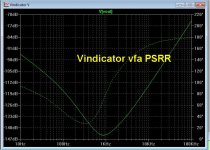 Vindicator V vfa psrr.jpg95.3 KB · Views: 417
Vindicator V vfa psrr.jpg95.3 KB · Views: 417 -
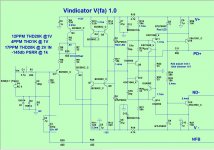 VindicatorV vfa schema.jpg174.4 KB · Views: 435
VindicatorV vfa schema.jpg174.4 KB · Views: 435 -
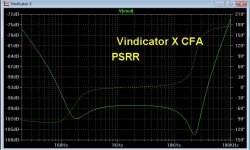 Vindicator X cfa psrr.jpg99.9 KB · Views: 429
Vindicator X cfa psrr.jpg99.9 KB · Views: 429 -
 Vindicator X cfa schema.jpg124.1 KB · Views: 462
Vindicator X cfa schema.jpg124.1 KB · Views: 462
... I just redid the "Vindicator X" .....
You are on a roll Pete. I look forward to building these.
You are on a roll Pete. I look forward to building these.
I want you all to build , and then try to kill these (below).
I want these to be indestructible. Super-pair VAS has the soft clip
here , too. 🙂 TO-92's only see short bursts of 4ma , also cool !
OS
Attachments
Especially on a CFA.
I just redid the "Vindicator X" ..... last of the new Vindicator series.
I have -100db over most of the audio spectrum.
PSRR is better than the VSSA/CFA-X.
- no over load of Q1/2 , no offset with the servo , Q1/2 thermals won't affect
the super pairs and no bad clip , either.
- "Gnome servo" + KyptonND VAS + CFA-X = a better CFA.
(Vindicator-X schema/psrr below 1-2)
By comparison , "Vindicator V" (vfa) is improved (below 3/4) ,
best PSRR of any design. All input stages are now 12V regulated , low current
BCxxx - all ready for SMD. 🙂
Think of bad PSRR as another feedback path that degrades performance
with output and frequency. This is why spooky and Kypton V2 are stellar
performers.
I attached "Vindicator X" (plus C/X) -.ASC's are below.
OS
Can you also show a PSSR graff from the kypton C ips to compare with the vindicator C?
ThxFor psrr , there is a big difference ....
(had to use the ND - same as C)
OS
Yes it should have been vindicator X sorry wrote C
What if you connect the ips boards to slewmaster will the PSRR change?
OS you mentioned working on a layout using SMD. Has anyone set any standards for working with Layout 6.0 and SMD... Any examples? Thanks for all of your hard and eloquent work, it is way past amazing to appreciate and in some cases listen to also.
While the designs are gravitating toward something fully SMD , searches
for high voltage .5A low Cob SOT-23's are harder (than to-126).
Fmmt497/597 looks like the perfect 3503/1381 VAS semi replacement.
All the other to-92's (BCxxx and 992/1845) have SOT equivalents.
It should be cool , resistors on the bottom ..... semi's on top. IPS's
would be 75 X 50mm - 1/2 size.
The FMMT's would need a few square CM of copper - that's it !
Most slew IPS's run ice cold with no high currents. NO issues.
OS
for high voltage .5A low Cob SOT-23's are harder (than to-126).
Fmmt497/597 looks like the perfect 3503/1381 VAS semi replacement.
All the other to-92's (BCxxx and 992/1845) have SOT equivalents.
It should be cool , resistors on the bottom ..... semi's on top. IPS's
would be 75 X 50mm - 1/2 size.
The FMMT's would need a few square CM of copper - that's it !
Most slew IPS's run ice cold with no high currents. NO issues.
OS
Fmmt497/597 - OS, thank you for a hint. Tried in a couple of simulations instead of 3503/1381 - looking good. SOA is also rather similar.
With regards to the standards - based on the experience, I use 1206 package for 1/4W resistors and all the small value capacitors, and 2412 for 1W resistors. Smaller packages are rather tricky to hand-solder 😉
With regards to the standards - based on the experience, I use 1206 package for 1/4W resistors and all the small value capacitors, and 2412 for 1W resistors. Smaller packages are rather tricky to hand-solder 😉
Fmmt497/597 - OS, thank you for a hint. Tried in a couple of simulations instead of 3503/1381 - looking good. SOA is also rather similar.
With regards to the standards - based on the experience, I use 1206 package for 1/4W resistors and all the small value capacitors, and 2412 for 1W resistors. Smaller packages are rather tricky to hand-solder 😉
As you see on the "vindicator" , everything before the TIS is 12V based.
For dual complimentary - BC847 p/n duals - BC847BPDW1T1G ON Semiconductor | Mouser
For dual (by gender) , for a leach/spooky amp - the toshiba HNxxxx series.
Bases are tied together for either cascodes or mirrors.
So , all 8 devices of a Leach amp front end could be 4 small dual SOT's.
BTW , it also looks as through all the SOT-363 dual's have the same pinout.
The ON's will sub for the Toshiba's. 😎
The same gender duals with connected bases have a different pinout - I
might not use those ( not universal enough).
The complimentary's would be an actual massive improvement for any
of the CFA stages , as the Toshiba HN1B04fu is gain matched for P/N.
All these pairs (diamonds , LTP pairs , cascodes , and mirrors) will also be
thermally coupled. VERY ideal for these designs.
OS
Last edited:
What about BCP56 replacement for 3503/1381 as it has a higher Ptot?While the designs are gravitating toward something fully SMD , searches
for high voltage .5A low Cob SOT-23's are harder (than to-126).
Fmmt497/597 looks like the perfect 3503/1381 VAS semi replacement.
All the other to-92's (BCxxx and 992/1845) have SOT equivalents.
It should be cool , resistors on the bottom ..... semi's on top. IPS's
would be 75 X 50mm - 1/2 size.
The FMMT's would need a few square CM of copper - that's it !
Most slew IPS's run ice cold with no high currents. NO issues.
OS
It is only a 80v device though. ..
- Home
- Amplifiers
- Solid State
- Slewmaster - CFA vs. VFA "Rumble"
